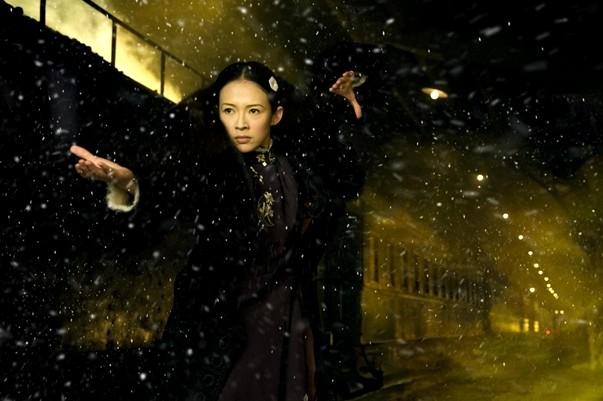By Armond White
During one of the intricately-edited fight scenes of Wong Kar-Wai’s The Grandmaster, his first feature in six years, I recalled asking Wong in 2008 if it was true that he was actually going to do a remake of Orson Welles’ 1946 The Lady From Shanghai? He replied “Yes, but that it won’t be same.” His enigmatic answer explains the splendor of The Grandmaster’s action scenes which owe less to the kung fu tradition of its story than to Welles’ dazzling barrage of romantic fantasy and existential fatalism.
 Each of The Grandmaster’s fight scenes–between lovers, rivals, equals and enemies–are so conceptually daring and thrilling they go beyond the genre’s established high standards to recall Welles’ Cubist mirror maze sequence in The Lady From Shanghai. It’s fair to imagine that cinematic connoisseur Wong (now call him “Wow!”) took that tour de force as a guide for his latest, noirish love excursion.
Each of The Grandmaster’s fight scenes–between lovers, rivals, equals and enemies–are so conceptually daring and thrilling they go beyond the genre’s established high standards to recall Welles’ Cubist mirror maze sequence in The Lady From Shanghai. It’s fair to imagine that cinematic connoisseur Wong (now call him “Wow!”) took that tour de force as a guide for his latest, noirish love excursion.
The Grandmaster plot is certainly different; only common for the kung fu tradition–the story of Ip Man, the real-life kung fu master best known for teaching Bruce Lee. Wong’s film shows Ip Man bringing together different martial arts styles native to China from 1936 to 1953, during years of tribal and national division and World War II. Ip Man (played by Tony Leung) Wong’s solemn, suave love-warrior familiar from Ashes of Time, falls in love with the daughter of China’s kung-fu leader, Gong Er (Ziyi Zhang) who, as a woman, is denied to practice the art despite her filial devotion and skill. Intrigued by Ip Man, she challenges him.
This competitive love story is as fraught with passion-and-restraint as David Lean’s great Brief Encounter. Wong pursues his usual romanticism while exploring martial arts ethics–ideas on virtue, vengeance and honor. Ip Man and Gong Er represent their culture’s complex traditions and morality. Wong salutes both with his postmodern expertise, gracing the kung fu genre with the grandest esthetics of the romantic imagination.
Each fight fulfills the genre’s narrative conventions yet Wong bases them in the characters’ personal motivation.( Jacques Demy displayed the same distinction in his French versions of American movie musicals.) Violent spectacle is less important than emotional expression–the proud smile Ip Man shows when jousting with his compatriots, Gong Er’s unsmiling determination when she fights for her family name. These are the year’s best action scenes since Man of Steel, containing splendid flourishes such as rain spinning off Ip Man’s white hat brim or his urgent rush towards an opponent then stopping for an elegant, balletic foot pivot.
Whether or not The Grandmaster pleases kung fu aficionados, the fights are like dances and the best have the dreamy, slowly-dawning excitement of amorous seduction. (Rogers and Astaire were never as romantic as this.) Wong has seen inside the esthetics of The Lady From Shanghai and applies them to a national epic, making The Grandmaster a cross-genre masterpiece. His slo-mo supplies nervous anticipation, “hesitant” rhythms that convey a fascination with movement, image and potentially unbound human ambition that, indeed, links this film to cinema’s heights.
Wong’s mastery of montage and portraiture evokes the superior expressivity of silent cinema. (At one point Ip Man and Gong Er exchange love letters depicted as intertitles.) During Er’s railroad station fight with Ma San (dashing Jin Zhang), the well-mixed train noise and soundtrack music are thrillingly elemental–a magnificent sound/image collage. And Ma San’s soliloquy is superb: gorgeous tragic emotion.
Yes, this is high-style filmmaking–with Wong’s natural chic–but it’s also a touchstone with cinema’s most stylish epics. Years pass as in Doctor Zhivago; fashion connotes character as in a woman’s leopard high-collar coat or the Marcel-waved hair of prostitutes in the Golden Pavillion brothel that evoke The Conformist. Best of all are Wong’s mesmerizing close-ups. He contemplates faces as did Josef Von Sternberg–and Leung and Zhang can act out the complicated feelings. Both have aged since Wong’s spellbinding 2046 but they’re capable of purity, seeming young at will, showing their characters’ spiritual essence. As in Sternberg (for example, Dishonored with Marlene Dietrich and Victor McLaglen) their mercurial feelings denote an entire way of life; the result is a kung fu movie that is also emotionally epic. The ideas spoken (“To yield is not to lose”) are not fortune cookie sentiments but astute realizations.
Not merely a stylist, Wong evokes more than just the Ip Man biography. The Grandmaster is about courage, passion and conviction. Through expression and gesture, Wong gets extraordinary feeling for circumstances that too many genre movies trivialize. When Er is challenged to abandon her family honor, her objection resonates from the cosmic to the personal—a profound trajectory that makes the story’s romance and sacrifice universal. The Grandmaster is what movies ought to be at their best. Through the rules of kung fu (“Being. Knowing. Doing.”) and his estheticized taste, Wong defines pure cinema.
Follow Armond White on Twitter at 3xchair
